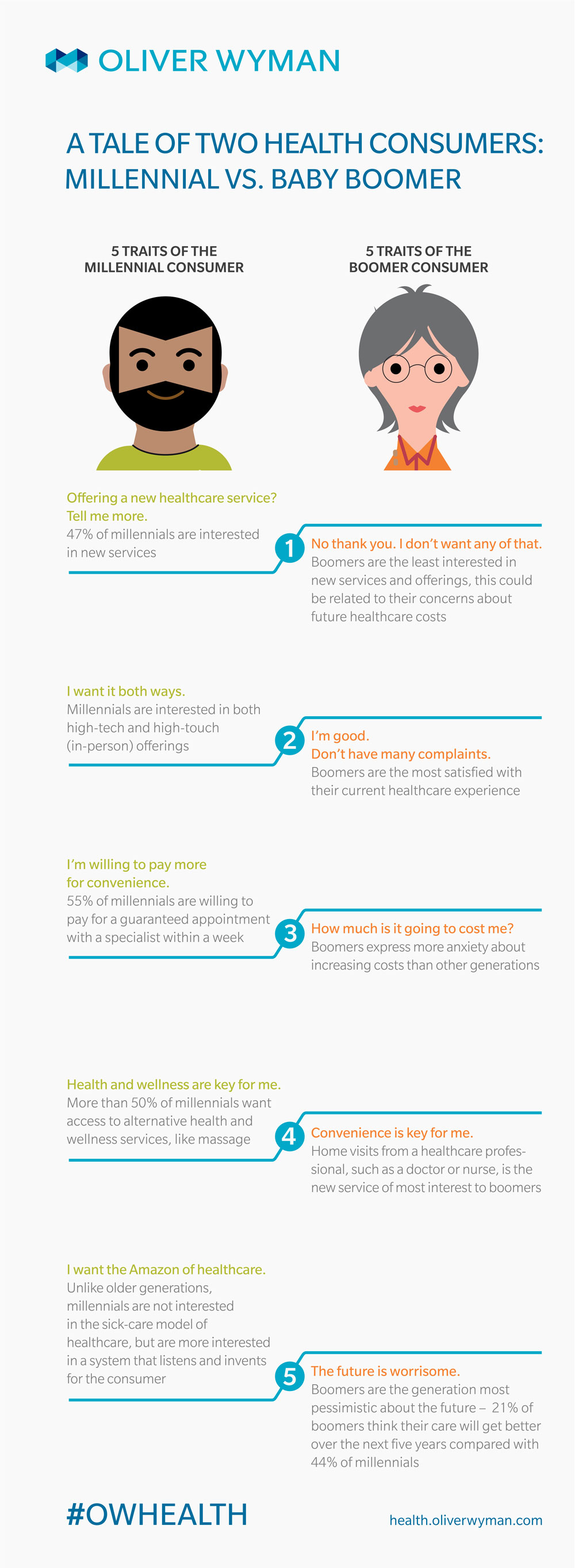In today’s consumer-driven health market, more consumers are taking control of their health and wellness decisions before – not after – they set foot in a physician’s office, urgent care center, or emergency room.
To discuss healthcare’s shift to consumerism, Helen Leis, partner, Health & Life Sciences, Oliver Wyman, recently chatted with Pratyusha Yalamanch, host of the radio show, Wharton University of Pennsylvania Business Radio on Sirius XM. (Listen to this episode here). Helen explains how healthcare’s consumer shift happened in the first place, who the big players are, and what the future of consumer-centric healthcare may look like. Here are five key takeaways from Helen’s consumer perspective.
1. Rising Healthcare Expenses Mean Consumers are Thinking Differently
Because consumers are dipping into their own wallets to pay for care, they are more sensitive to price and quality than before.
“We’re at a point where the average consumer in an average year pays for all their healthcare costs,” says Helen. “I’m not talking about the sickest of the sick, but if you look at the averages, consumers are spending that money out-of-pocket because the first couple thousand dollars – in some cases $5,000, $6,000, or $7,000 – is out-of-pocket before health insurance kicks in.”
When consumers pay themselves, they tend to make different medical choices, such as deciding to wait and see a physician until absolutely necessary or delaying an expensive prescription refill.
“Consumers are saying, ‘Wait a minute. Maybe I don’t need the third EpiPen, and I should make do with one or two,'” Helen says.
And when healthcare competes with many other items in a consumer’s household budget, swallowing a deductible becomes all the more challenging.
“When a consumer’s [gross] household income is something like $70,000 a year, it’s a lot tougher to swallow a $5,000 deductible. So they’re going to think differently about how and what they’re spending on, and make careful, informed choices,” she adds.
Although greater data transparency is helping consumers make these more intelligent, informed care decisions, it’s often a difficult task for consumers to make sense of data available at their fingertips.
“From a consumer perspective, these transparency tools or cost estimators that an insurer may offer presumes you know what to research,” Helen says. “It presumes you know you need to look up the cost of a shoulder MRI, for example. And oftentimes what consumers are thinking about and looking for is the crystal ball of what is likely to happen and what they are likely to need.”
"Oftentimes what consumers are thinking about and looking for is the crystal ball of what is likely to happen and what they are likely to need.”
2. Consumers Value Emotional Support / Bedside Manner and Care Outcomes Differently
Helen says there’s a fine line between quality measures and experience measures. Managing bedside manner may matter more or less than how skilled an open heart surgeon is, depending on who you ask.
“My mom needed open heart surgery several years ago. She didn’t want to go with the cardiac surgeon her cardiologist recommended because she didn’t like his style with her and the way he interacted with her,” she says. “I went with her to talk with him, and I asked: ‘How many people have died on your table?’ He said, ‘Zero.’ And I said, ‘How many procedures have you done like this?’ And it was 10,000 or 12,000.”
“You say, ‘Great, I don’t care if you’re not super kind to my mother. But you have the success statistics I’m looking for. I can live with that.’”
But, someone managing diabetes, for example, might be more concerned about the emotional support they are getting from clinical professionals who are advising them on how to manage their blood sugar levels.
“Sometimes [a diabetes patient may] need the social and emotional support around how to think about navigating situations where you might be enticed to make food choices that you know aren’t good for you,” she says. “And that takes a softer touch.”
3. Millennial Consumers Have a Different Healthcare Outlook Than Baby Boomers
Millennials, in particular, are especially interested in both quality measures and experience measures. Millennials tend to have different healthcare preferences compared to Baby Boomers, for example.
“At first glance, consumers say, ‘I’m okay with the status quo.’ But they’re worried about healthcare costs, health insurance costs, and things like access and quality of care.”
“When millennials receive a diagnosis, they then look for what technology and services are available to make the journey better, and they also want financial planning and navigation advice,” she explains.
But Baby Boomers, says Helen, tend to be more accustomed to the status quo. “They kind of know the journey, and they’re comfortable with the steps. They don’t need the financial planning and advice either. Interestingly, they are not expecting their healthcare to get better in the future – which is different than what millennials expect,” she points out.
4. Traditional Healthcare Providers Need to React Differently to a New Consumer-Driven Health Market to Stay Afloat
An individual physician trying to manage a panel of a couple thousand patients is often hindered by the very systems and infrastructure they depend on.
“You have to call my children’s former pediatrician between eight and five for an appointment. If you don’t get a live person, you get a voicemail,” Helen explains. “I love the pediatrician. But that does not work.”
“So I asked around, and it goes back to Yelp style reviews. Friends’ recommendations matter. We found pediatricians available for appointments in the office until 7:30 at night. They accept and reply to emails. They have an online portal,” she says.
"Once you crack what matters most to that individual consumer, you have a bond that is hard for others to replicate. That’s where you want to be in the future health market."
5. Outside Players Are Making Consumer Trust a Top Priority
Incumbents from industries outside of healthcare, such as retail and technology, are keeping a close watch on healthcare’s $3 trillion spend, and wondering how they might better serve healthcare consumers. And those from inside and outside of healthcare are joining forces, such as the recently announced Comcast-Independence Blue Cross venture to create a consumer health technology platform, or the Amazon-Chase-Berkshire trifecta.
“Companies in B2C businesses today sit on data about consumers and have designed very compelling consumer experiences. If you think about Amazon, for everything from 1-Click to Prime, they’ve nailed it for the consumer. And if you think about Berkshire Hathaway, one of their portfolio companies is Geico,” she says. “Geico took an industry and a product that was not interesting, engaging, or emotional for a consumer, and made it funny and interesting – people talk about the Gecko. It’s a branding opportunity in a sector where people didn’t really think was possible.”
These kinds of capabilities are causing health insurers and healthcare providers to ask how they can do business differently to drive innovative capabilities grounded in addressing consumer need and creating economic value.
After all, the days of getting socked with a Blockbuster late fee rental became a thing of the past once Netflix redesigned the consumer video consumption experience, albeit not without some hesitation from consumers along the way who were perhaps initially skeptical to have DVDs delivered to their mailbox.
“Their moves forced Blockbuster to get rid of the late fees. Forbes Magazine characterized those fees as the real Achilles’ heel of the Blockbuster model. Blockbuster’s problem was that economic value was predicated on customers paying late fees,” says Helen. “Then Netflix disrupted themselves again and said, ‘Actually, we think streaming is the way of the future, and people are going to want immediate consumption.’”
“They took that five-day experience that ended with a late fee down to an instant experience. And as a result, they changed consumers’ behaviors.”
And these evolving – and highly trackable – consumer behaviors provide insight. Netflix relies on actual viewing data, rather than Nielsen ratings – to understand consumer viewing patterns and anticipate what content they’ll value most, Helen explained.
As voice recognition software, like Amazon’s Alexa, becomes a valuable health and healthcare tool, the most successful companies will be the ones consumers trust their data with.
“Because I’ve let Alexa into my home, she knows very personal information about me like when I turn off the lights and what music I listen to,” she says. “The right brands have built trust so we will allow them more permission. I think the trick is the first time it’s compromised, my guess would be there’s no going back.”
Building trust starts with authentic, genuine, personalized, and transparent interaction. As service models change, insurers can be viewed as patient champions and advocates.
“They sit on all or most of the data in terms of what procedures or conditions have what types of treatments, which ones are more efficacious, which ones get better outcomes, and what provider is better at this and that. Yelp’s not going to give you that,” she says.
But in terms of technology’s potential – like digital health apps – to transform the consumer experience, Helen says this process is still too fragmented and siloed to be impactful.
“There are tens of thousands of digital health apps in the app store. We haven’t seen the category killer yet, the one that knits together the jobs the consumer needs you to do in a personalized way – in the way Amazon feels to us today with retail shopping – while also addressing the nature of the system.”
“The provider’s data sits separately from the insurer’s data. No one has a whole picture of you yet. Those who start to knit together the holistic picture of an individual across all the touchpoints in the healthcare system are going to have a powerful offering.”
But Helen says tracking consumers through the collection of various pieces of information has its challenges. For one thing, consumers are often overwhelmed by biometric remote monitoring systems that track consumers’ heart rate, sleep patterns, steps, and resting heart rate.
“You get to a point where you feel like everything in your life is a data point, and you just want a little head space. We’re starting to see more wearables being left in the drawer for the weekend,” she says. “Without connection to guidance around how to use data and how to change behaviors, it’s hard for folks to plug into it and know what they should be doing.”
Designing the right non-intrusive offering that provides valuable information without making a consumer feel like someone’s is looking over her shoulder is key.
“Getting closer to the consumer in healthcare is increasingly a source of strategic control. There are several paths to build a strong relationship – help consumers save money, address a pervasive hassle, or receive needed advice, for example. Once you crack what matters most to that individual consumer, you have a bond that is hard for others to replicate. That’s where you want to be in the future health market.”


